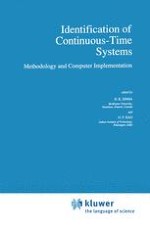1991 | OriginalPaper | Buchkapitel
Adaptive Model Approaches
verfasst von : H. Unbehauen
Erschienen in: Identification of Continuous-Time Systems
Verlag: Springer Netherlands
Enthalten in: Professional Book Archive
Aktivieren Sie unsere intelligente Suche, um passende Fachinhalte oder Patente zu finden.
Wählen Sie Textabschnitte aus um mit Künstlicher Intelligenz passenden Patente zu finden. powered by
Markieren Sie Textabschnitte, um KI-gestützt weitere passende Inhalte zu finden. powered by
In this Chaper algorithms for identification of continuous-time systems based on model reference principles will be presented. The main idea behind the model reference principle is to set up a procedure for adjustment, based on a comparison between the performance of two units, one of which serves as a reference for the other to follow. The adjustment is made on the unit which follows the reference unit in such a way that the discrepancy between the performance of the two units is minimized or reduced to zero. In the case of the identification problem the plant to be identified assumes the role of the reference model and the estimated model assumes the role of the adjustable unit. It is this dual character of the model reference principle that enables us to apply several techniques of the well known Model Reference Adaptive Control (MRAC) Systems (Landau 1979) to the identification problem. In order to assign distinct identity to this class of adaptive model techniques for identification, we will call them System Reference Adaptive Model (SRAM) techniques. These techniques may be further classified on the basis of the following features: a)Structure: In accordance with the disposition of the adjustable model with respect to the reference system the SRAM schemes can be classified as i) parallel, ii) series and iii) series-parallel schemes.b)Design method: There are mainly three design methods viz. 1)Local optimization (e.g. gradient methods),2)Liapunov’s second method, and3)Hyperstable design method.
